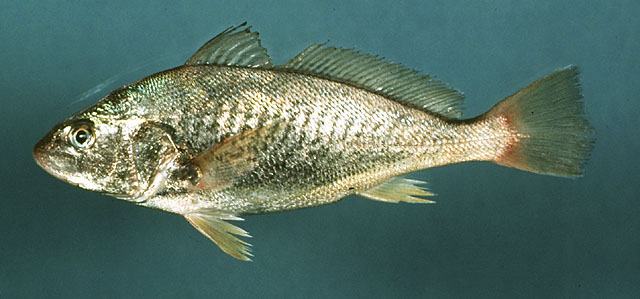Atlantic Croaker Fish

Croaker fish, also known as drum fish or the Atlantic Croaker, is the common name of the Sciaenidae. They got the name "croaker" or "drum fish" from a peculiar repetitive sound they make which sounds like a loud croak or a drum beating. They live in brackish and/or salt water and can be found in several places along the east coast.
In appearance, the croaker is actually quite average. It has a silver-toned body that almost seems to glow pink in certain lights. Its belly is either silvery white or, in some rare cases, brassy white. It also has brassy spots on its back and dorsal fin, but they're so indistinct, they look more like faint, barely-there stripes than spots.
A typical length for croakers is between 18 and 20 inches, but some have been known to reach lengths of two feet. They usually weigh less than a pound. They're dorsal fins are deeply notched, while their tail fins point slightly. They also have a unique chin. Their croaking sound, though, is really what makes them so instantly recognizable.
Croaker Fishing: Where to Find Them
Croaker fish can be found anywhere in central Florida waters and along the Atlantic coast all the way up to New Jersey. They can also be found in the north waters of the Gulf of Mexico. They're most often caught in bays with sandy, hard bottoms, near beaches in river outlets and in the surf.
Croakers are most active in summer, late spring and early fall. During these times, they're regularly moving in large schools from place to place, often into estuaries. Their school sizes are usually quite large, which allows you to catch several fish from the same school once you've located them. This particular aspect of fishing for croakers is what makes them so much fun for beginner fishermen and kids.
When it comes to limits on catching croakers, most states don't have any. Those few states that do regulate fishing for croaker allow very large numbers of croakers to be taken home. However, as with any other species of fish, overfishing can damage the population, so always use discretion and good judgment when taking home your catches.
It's also important to check out the published laws of any state in which you plan to go fishing beforehand, just to avoid getting into any legal trouble.
Croaker Fishing: How to Catch Them
Rod, Reel and Rig Set-Up
When it comes to fishing for croaker, the best equipment falls in the light to medium range for your rod and reel. You'll want your rig to be a deep-diving, bottom fishing configuration that lets you get down deep enough to catch them. The rig works best with a 1/0 hook. You'll also need a weight of about two ounces, which will keep your lure on the water's bottom.
Croakers Bait
Croakers love live bait. The best croaker bait is fish or shrimp. When using shrimp, you can use either fresh or frozen, though fresh does tend to work better. Other options include fiddler crabs, sand fleas or other cut fish or seafood, such as squid or mullet. In fact, you can even use pieces from any small croaker fish that you catch to lure in larger croakers.
If you prefer, you can also use artificial/synthetic bait to fish for croaker. Artificial lures aren't quite as effective as actual food. However, because croakers are so numerous and swim in such large schools, you're still likely to catch some with artificial bait, and there are some advantages to using it.
First of all, artificial bait and lures don't have to be kept in coolers or refrigerators when not in use. This is very handy when you don't want to have to lug around a big cooler. With artificial bait, there really are no special storage requirements at all.
There are also a wide range of options from which you can choose when using synthetic bait. These lures come in all different colors and shapes, and some of them are even scented to attract croakers specifically. You can also find artificial bait for your own specific favorite type of fishing, whether it be jigging, trolling, casting or drift fishing.
Safety Concerns
Croakers aren't very large fish, and they don't usually bite once you've caught them. However, you'll want to always handle them while wearing gloves or using some type of cloth to protect your hands from their gills. Their gills are incredibly sharp, and if they cut you with them, the cut can be quite painful. It's best not to let your small children handle them once they've been caught.